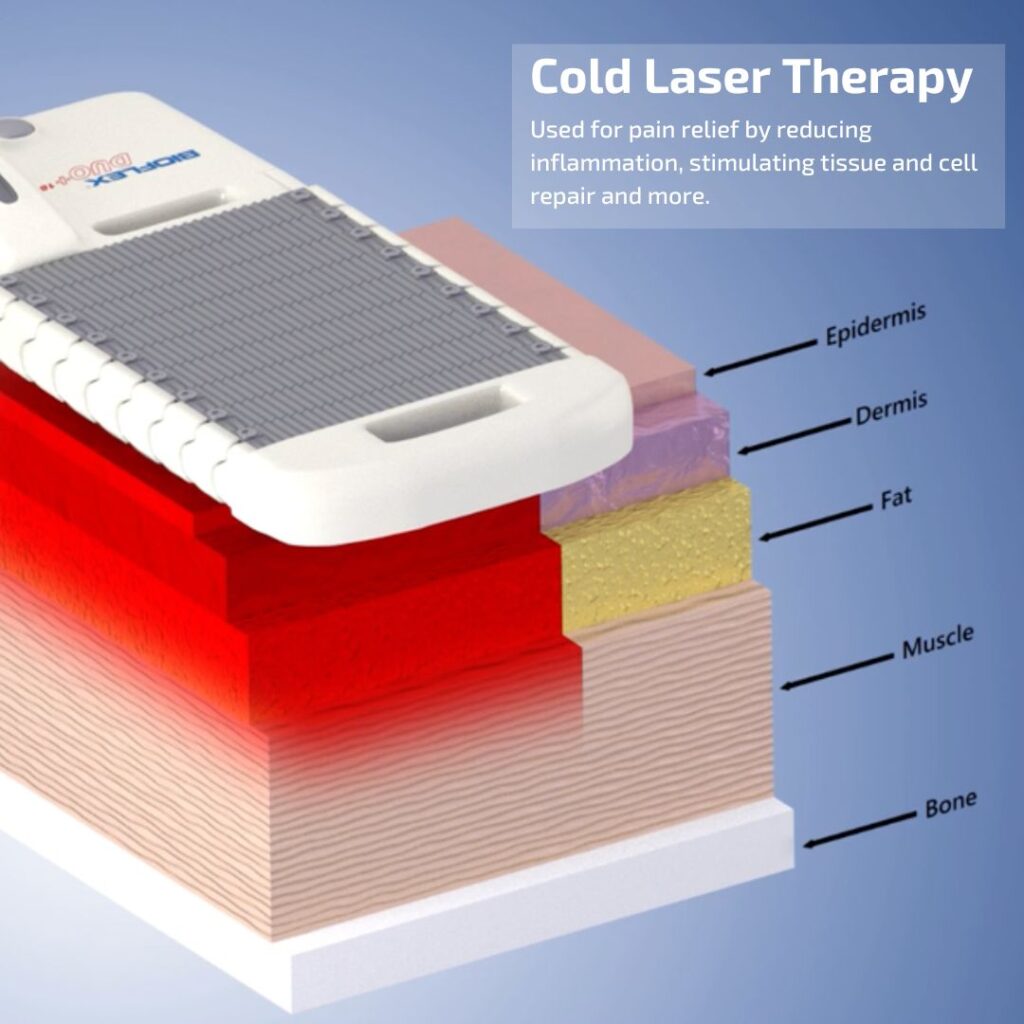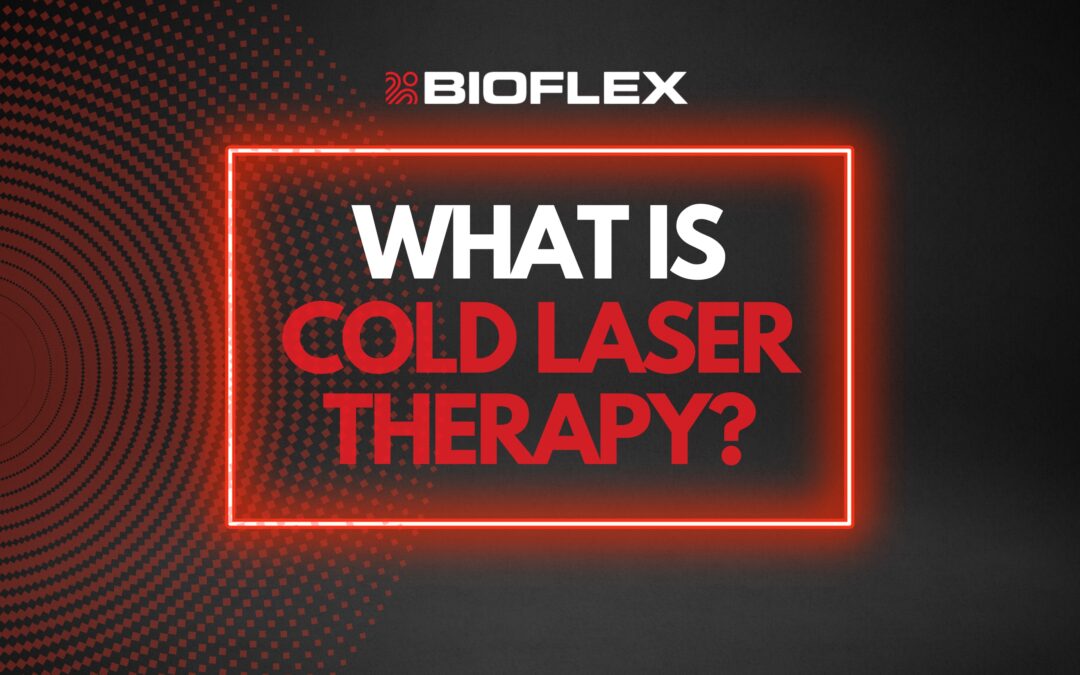What exactly is cold laser therapy and how does it work? In this blog post, we’ll take a closer look at this emerging medical technology and explore how it may offer an innovative approach to treating a variety of conditions.
 Cold laser therapy works by using low levels of light energy (photons) of specific wavelengths that are absorbed into the body and stimulate cellular activity in injured tissues in the targeted area. This increased cellular activity promotes tissue repair and regeneration, increases collagen secretion and decreases active inflammation.
The light energy stimulates the production of ATP (energy source of cells) in cells that are metabolically impaired due to injury and inflammation. As ATP energy levels increase, the cells and tissues respond by increasing their capacity for repair and regeneration.
Cold laser therapy is able to target specific regions of the body when applied directly to the skin over the injured or diseased area making it a highly effective form of therapy. It is often used in conjunction with other treatments to help with a wide range of conditions that cause pain, inflammation, and tissue damage.
The benefits of cold laser therapy are numerous, and it is a highly effective and non-invasive option for many individuals seeking relief from a variety of conditions.
Cold laser therapy works by using low levels of light energy (photons) of specific wavelengths that are absorbed into the body and stimulate cellular activity in injured tissues in the targeted area. This increased cellular activity promotes tissue repair and regeneration, increases collagen secretion and decreases active inflammation.
The light energy stimulates the production of ATP (energy source of cells) in cells that are metabolically impaired due to injury and inflammation. As ATP energy levels increase, the cells and tissues respond by increasing their capacity for repair and regeneration.
Cold laser therapy is able to target specific regions of the body when applied directly to the skin over the injured or diseased area making it a highly effective form of therapy. It is often used in conjunction with other treatments to help with a wide range of conditions that cause pain, inflammation, and tissue damage.
The benefits of cold laser therapy are numerous, and it is a highly effective and non-invasive option for many individuals seeking relief from a variety of conditions.
 As previously mentioned, the low-level energy from cold laser therapy stimulates cellular activity, which can lead to improved circulation and tissue repair. By increasing cell replication and circulation, this therapy promotes the regeneration of damaged tissue and the reduction of inflammation. Improved circulation can bring vital nutrients and oxygen to the affected area, aiding in the healing process.
This therapy has shown promising results in reducing pain and accelerating wound healing. Reducing scar tissue and improving joint mobility and muscle strength are significant benefits that have led many physiotherapists, chiropractors, and health care professionals to include this FDA and Health Canada approved treatment in their practice.
The increased cellular activity from cold laser therapy offers a safe and effective option for those looking to alleviate pain and promote healing.
As previously mentioned, the low-level energy from cold laser therapy stimulates cellular activity, which can lead to improved circulation and tissue repair. By increasing cell replication and circulation, this therapy promotes the regeneration of damaged tissue and the reduction of inflammation. Improved circulation can bring vital nutrients and oxygen to the affected area, aiding in the healing process.
This therapy has shown promising results in reducing pain and accelerating wound healing. Reducing scar tissue and improving joint mobility and muscle strength are significant benefits that have led many physiotherapists, chiropractors, and health care professionals to include this FDA and Health Canada approved treatment in their practice.
The increased cellular activity from cold laser therapy offers a safe and effective option for those looking to alleviate pain and promote healing.
Introduction to Cold Laser Therapy
Cold laser therapy is also known as low-level laser therapy (LLLT) or photobiomodulation therapy (PBMT) and is a non-invasive therapeutic treatment that applies low-level lasers or light-emitting diodes (LEDs) to stimulate healing and reduce inflammation and pain. Unlike surgery or medication, cold laser therapy offers a non-invasive and non-addicting option that eliminates the well known side effects associated with long-term medication use. The treatment method is called “cold” laser therapy because the energy level of light used is not enough to heat your body’s tissue. This is why LEDs can also be used as they don’t cause heating. This light energy passes through the skin into deeper injured or inflamed tissues and stimulates cellular activity that assists with tissue repair as well as releasing nitric oxide that increases circulation.How Does Cold Laser Therapy Work?
 Cold laser therapy works by using low levels of light energy (photons) of specific wavelengths that are absorbed into the body and stimulate cellular activity in injured tissues in the targeted area. This increased cellular activity promotes tissue repair and regeneration, increases collagen secretion and decreases active inflammation.
The light energy stimulates the production of ATP (energy source of cells) in cells that are metabolically impaired due to injury and inflammation. As ATP energy levels increase, the cells and tissues respond by increasing their capacity for repair and regeneration.
Cold laser therapy is able to target specific regions of the body when applied directly to the skin over the injured or diseased area making it a highly effective form of therapy. It is often used in conjunction with other treatments to help with a wide range of conditions that cause pain, inflammation, and tissue damage.
The benefits of cold laser therapy are numerous, and it is a highly effective and non-invasive option for many individuals seeking relief from a variety of conditions.
Cold laser therapy works by using low levels of light energy (photons) of specific wavelengths that are absorbed into the body and stimulate cellular activity in injured tissues in the targeted area. This increased cellular activity promotes tissue repair and regeneration, increases collagen secretion and decreases active inflammation.
The light energy stimulates the production of ATP (energy source of cells) in cells that are metabolically impaired due to injury and inflammation. As ATP energy levels increase, the cells and tissues respond by increasing their capacity for repair and regeneration.
Cold laser therapy is able to target specific regions of the body when applied directly to the skin over the injured or diseased area making it a highly effective form of therapy. It is often used in conjunction with other treatments to help with a wide range of conditions that cause pain, inflammation, and tissue damage.
The benefits of cold laser therapy are numerous, and it is a highly effective and non-invasive option for many individuals seeking relief from a variety of conditions.
Cold laser therapy uses low-level light energy to stimulate healing and reduce pain
The procedure involves irradiating specific wavelengths and dosages of light energy which penetrate the skin and to affect the cellular activity of deeper injured tissues. The light energy can also improve circulation which promotes decreased swelling as well as tissue repair. The light energy is also absorbed by white blood cells in your blood leading to decreased inflammation and pain.This light penetrates the skin and stimulates cellular activity
As mentioned in the previous section, cold laser therapy works by stimulating cellular activity. When red and near infrared wavelengths of the light energy penetrates the skin, it interacts with the cells and triggers a photochemical reaction similar to photosynthesis in which the sun’s energy is absorbed by chlorophyll in plants resulting in growth. Whether you’re dealing with a sports injury or chronic pain, cold laser therapy can help kickstart your body’s natural healing process.The increased cellular activity can improve circulation and help with tissue repair
 As previously mentioned, the low-level energy from cold laser therapy stimulates cellular activity, which can lead to improved circulation and tissue repair. By increasing cell replication and circulation, this therapy promotes the regeneration of damaged tissue and the reduction of inflammation. Improved circulation can bring vital nutrients and oxygen to the affected area, aiding in the healing process.
This therapy has shown promising results in reducing pain and accelerating wound healing. Reducing scar tissue and improving joint mobility and muscle strength are significant benefits that have led many physiotherapists, chiropractors, and health care professionals to include this FDA and Health Canada approved treatment in their practice.
The increased cellular activity from cold laser therapy offers a safe and effective option for those looking to alleviate pain and promote healing.
As previously mentioned, the low-level energy from cold laser therapy stimulates cellular activity, which can lead to improved circulation and tissue repair. By increasing cell replication and circulation, this therapy promotes the regeneration of damaged tissue and the reduction of inflammation. Improved circulation can bring vital nutrients and oxygen to the affected area, aiding in the healing process.
This therapy has shown promising results in reducing pain and accelerating wound healing. Reducing scar tissue and improving joint mobility and muscle strength are significant benefits that have led many physiotherapists, chiropractors, and health care professionals to include this FDA and Health Canada approved treatment in their practice.
The increased cellular activity from cold laser therapy offers a safe and effective option for those looking to alleviate pain and promote healing.
